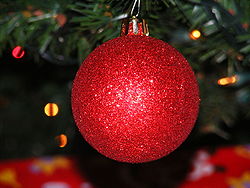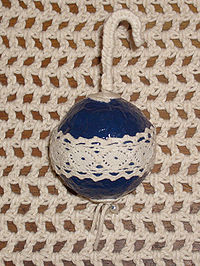
Christmas ornament
Encyclopedia


Glass
Glass is an amorphous solid material. Glasses are typically brittle and optically transparent.The most familiar type of glass, used for centuries in windows and drinking vessels, is soda-lime glass, composed of about 75% silica plus Na2O, CaO, and several minor additives...
, metal
Metal
A metal , is an element, compound, or alloy that is a good conductor of both electricity and heat. Metals are usually malleable and shiny, that is they reflect most of incident light...
, wood
Wood
Wood is a hard, fibrous tissue found in many trees. It has been used for hundreds of thousands of years for both fuel and as a construction material. It is an organic material, a natural composite of cellulose fibers embedded in a matrix of lignin which resists compression...
or ceramic
Ceramic
A ceramic is an inorganic, nonmetallic solid prepared by the action of heat and subsequent cooling. Ceramic materials may have a crystalline or partly crystalline structure, or may be amorphous...
s) that are used to festoon a Christmas tree
Christmas tree
The Christmas tree is a decorated evergreen coniferous tree, real or artificial, and a tradition associated with the celebration of Christmas. The tradition of decorating an evergreen tree at Christmas started in Livonia and Germany in the 16th century...
.
Ornaments take many different forms, from a simple round ball to highly artistic designs. Ornaments are almost always reused year after year, rather than purchased annually, and family collections often contain a combination of commercially produced ornaments and decorations created by family members. Such collections are often passed on and augmented from generation to generation.
Santa Claus
Santa Claus
Santa Claus is a folklore figure in various cultures who distributes gifts to children, normally on Christmas Eve. Each name is a variation of Saint Nicholas, but refers to Santa Claus...
is a commonly used figure. Candy cane
Candy cane
A candy cane is a hard cane-shaped candy stick. It is traditionally white with red stripes and flavored with peppermint or cinnamon; however, it is also made in a variety of other flavors and may be decorated with stripes of different colors and thicknesses...
s, fruit, animals, snowmen, angel
Angel
Angels are mythical beings often depicted as messengers of God in the Hebrew and Christian Bibles along with the Quran. The English word angel is derived from the Greek ἄγγελος, a translation of in the Hebrew Bible ; a similar term, ملائكة , is used in the Qur'an...
s and snowflake
Snowflake
Snowflakes are conglomerations of frozen ice crystals which fall through the Earth's atmosphere. They begin as snow crystals which develop when microscopic supercooled cloud droplets freeze. Snowflakes come in a variety of sizes and shapes. Complex shapes emerge as the flake moves through...
imagery are also popular choices.
Lucretia P. Hale's story "The Peterkins' Christmas-Tree" offers a short catalog of the sorts of ornaments used in the 1870s:
- "There was every kind of gilt hanging-thing, from gilt pea-pods to butterflies on springs. There were shining flags and lanterns, and bird-cages, and nests with birds sitting on them, baskets of fruit, gilt apples, and bunches of grapes."
The modern-day Christmas ornament was originally invented in the small German town of Lauscha in the mid-19th century.
Bauble

Invention
The first decorated trees were adorned with apples, strings of popcorn, white candy canes and pastries in the shapes of stars, hearts and flowers. GlassGlass
Glass is an amorphous solid material. Glasses are typically brittle and optically transparent.The most familiar type of glass, used for centuries in windows and drinking vessels, is soda-lime glass, composed of about 75% silica plus Na2O, CaO, and several minor additives...
baubles were first made in Lauscha
Lauscha
Lauscha is a town in the district of Sonneberg, in Thuringia, Germany. It is situated 13 km north of Sonneberg, and 24 km southwest of Saalfeld. It became known for its glassblowing.-Geography:...
, Germany
Germany
Germany , officially the Federal Republic of Germany , is a federal parliamentary republic in Europe. The country consists of 16 states while the capital and largest city is Berlin. Germany covers an area of 357,021 km2 and has a largely temperate seasonal climate...
, by Hans Greiner who produced garlands of glass beads similar to the popcorn strands and tin
Tin
Tin is a chemical element with the symbol Sn and atomic number 50. It is a main group metal in group 14 of the periodic table. Tin shows chemical similarity to both neighboring group 14 elements, germanium and lead and has two possible oxidation states, +2 and the slightly more stable +4...
figures that could be hung on trees. The popularity of these decorations grew into the production of glass figures made by highly skilled artisans with clay
Clay
Clay is a general term including many combinations of one or more clay minerals with traces of metal oxides and organic matter. Geologic clay deposits are mostly composed of phyllosilicate minerals containing variable amounts of water trapped in the mineral structure.- Formation :Clay minerals...
molds.
The artisans heated a glass tube over a flame, then inserted the tube into a clay mold, blowing the heated glass to expand into the shape of the mold. The original ornaments were only in the shape of fruits and nuts.
After the glass cooled, a silver nitrate
Silver nitrate
Silver nitrate is an inorganic compound with chemical formula . This compound is a versatile precursor to many other silver compounds, such as those used in photography. It is far less sensitive to light than the halides...
solution was swirled into it, a silvering technique developed in the 1850s by Justus von Liebig
Justus von Liebig
Justus von Liebig was a German chemist who made major contributions to agricultural and biological chemistry, and worked on the organization of organic chemistry. As a professor, he devised the modern laboratory-oriented teaching method, and for such innovations, he is regarded as one of the...
. After the nitrate solution dried, the ornament was hand-painted and topped with a cap and hook.
Export
Other glassblowers in Lauscha recognised the growing popularity of Christmas baubles and began producing them in a wide range of designs. Soon, the whole of Germany began buying Christmas glassware from Lauscha. On Christmas Eve 1832, a young Queen Victoria wrote about her delight at having a tree, hung with lights, ornaments, and presents placed round it. In the 1840s, after a picture of Victoria's Christmas tree was shown in a London newspaper decorated with glass ornaments and baubles from her husband Prince Albert's native Germany, Lauscha began exporting its products throughout Europe.In the 1880s, American F. W. Woolworth discovered Lauscha's baubles during a visit to Germany. He made a fortune by importing the German glass ornaments to the U.S.A.
Mass production
The first American-made glass ornaments were created by William DeMuth in New York in 1870. In 1880, Woolworth'sF. W. Woolworth Company
The F. W. Woolworth Company was a retail company that was one of the original American five-and-dime stores. The first successful Woolworth store was opened on July 18, 1879 by Frank Winfield Woolworth in Lancaster, Pennsylvania, as "Woolworth's Great Five Cent Store"...
began selling Lauscha glass ornaments. Other stores began selling Christmas ornaments by the late 19th century and by 1910, Woolworth's had gone national with over 1000 stores bringing Christmas ornaments across America. New suppliers popped up everywhere including Dresden
Dresden
Dresden is the capital city of the Free State of Saxony in Germany. It is situated in a valley on the River Elbe, near the Czech border. The Dresden conurbation is part of the Saxon Triangle metropolitan area....
die-cut fiberboard ornaments which were popular among families with small children.
By the 20th century, Woolworth's had imported 200,000 ornaments and topped $25 million in sales from Christmas decorations alone. As of 2009, the Christmas decoration industry ranks second to gifts in seasonal sales. Gloria Duchin, Inc., just one of the industry's Christmas ornament manufacturers and designers today, has over 100 million ornaments in circulation and produces millions of new ornaments each year.
Post World War II
After World War IIWorld War II
World War II, or the Second World War , was a global conflict lasting from 1939 to 1945, involving most of the world's nations—including all of the great powers—eventually forming two opposing military alliances: the Allies and the Axis...
, the East German government
Volkskammer
The People's Chamber was the unicameral legislature of the German Democratic Republic . From its founding in 1949 until the first free elections on 18 March 1990, all members of the Volkskammer were elected on a slate controlled by the Socialist Unity Party of Germany , called the National Front...
turned most of Lauscha's glassworks into state-owned entities, and production of baubles in Lauscha ceased. After the Berlin Wall
Berlin Wall
The Berlin Wall was a barrier constructed by the German Democratic Republic starting on 13 August 1961, that completely cut off West Berlin from surrounding East Germany and from East Berlin...
came down, most of the firms were reestablished as private companies. As of 2009, there are still about 20 small glass-blowing firms active in Lauscha that produce baubles. One of the producers is Krebs Glas Lauscha, part of the Krebs family which is now one of the largest producers of glass ornaments worldwide.
The modern bauble
Although glass baubles are still produced, baubles are now frequently made from plasticPlastic
A plastic material is any of a wide range of synthetic or semi-synthetic organic solids used in the manufacture of industrial products. Plastics are typically polymers of high molecular mass, and may contain other substances to improve performance and/or reduce production costs...
and available worldwide in a huge variety of shapes, colors and designs.
Tree-topper

The Fir-Tree
"The Fir-Tree" is a literary fairy tale by Danish poet and author Hans Christian Andersen . The tale is about a fir tree so anxious to grow up, so anxious for greater things, that he cannot appreciate living in the moment. The tale was first published 21 December 1844 with "The Snow Queen" in...
describes the decoration of a Danish Christmas tree:
- On one branch there hung little nets cut out of colored paper, and each net was filled with sugarplums; and among the other boughs gilded apples and walnuts were suspended, looking as though they had grown there, and little blue and white tapers were placed among the leaves. Dolls that looked for all the world like men—the Tree had never beheld such before—were seen among the foliage, and at the very top a large star of gold tinsel was fixed.
In American English, this is called a "tree-topper". Glass spire-like ornaments are popular. Plastic tree toppers are often electrified and, once connected with the tree's strings of colored lights, glow from within. Following WWII, various Christmas icons, such as Santa Claus, were introduced as electrified tree toppers. The angel and star however remained the preferred topper.
See also
- Bauble
- Christmas treeChristmas treeThe Christmas tree is a decorated evergreen coniferous tree, real or artificial, and a tradition associated with the celebration of Christmas. The tradition of decorating an evergreen tree at Christmas started in Livonia and Germany in the 16th century...
- Snow babySnow babyA snow baby is a small figurine that depicts some aspect of the Christmas holidays or of winter sports. The traditional snow baby is made of unglazed porcelain and shows a child dressed in a snowsuit; the suit itself is covered in small pieces of crushed bisque, giving the appearance of fallen...
- Pleated Christmas heartsPleated Christmas heartsPleated Christmas hearts is a Danish and north German Christmas tree ornament.The exact age and origin of the tradition is unknown, but the oldest known pleated Christmas hearts was made by the Danish fairy tale author Hans Christian Andersen in 1860, but the heart has no handle, and therefore...

